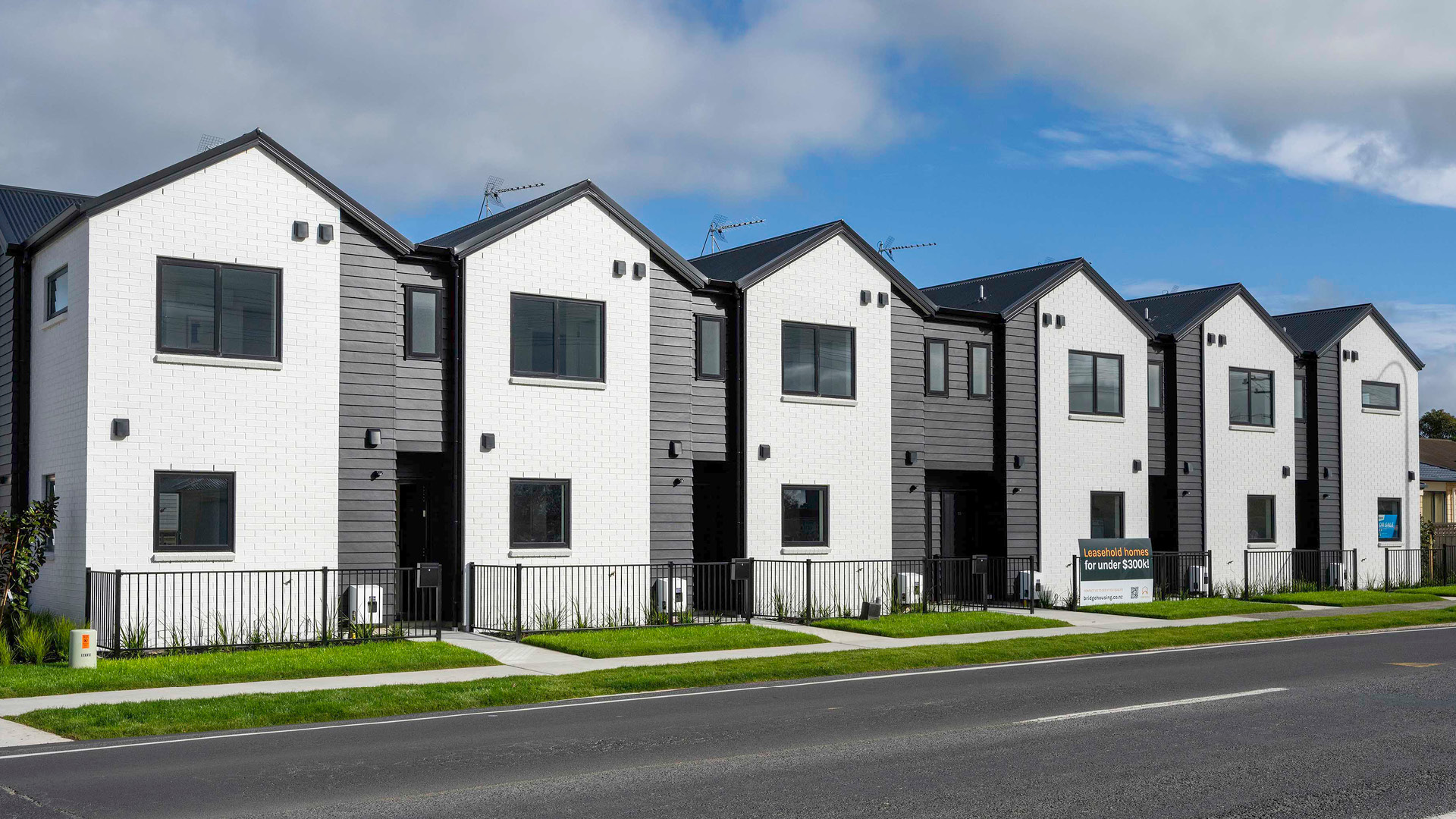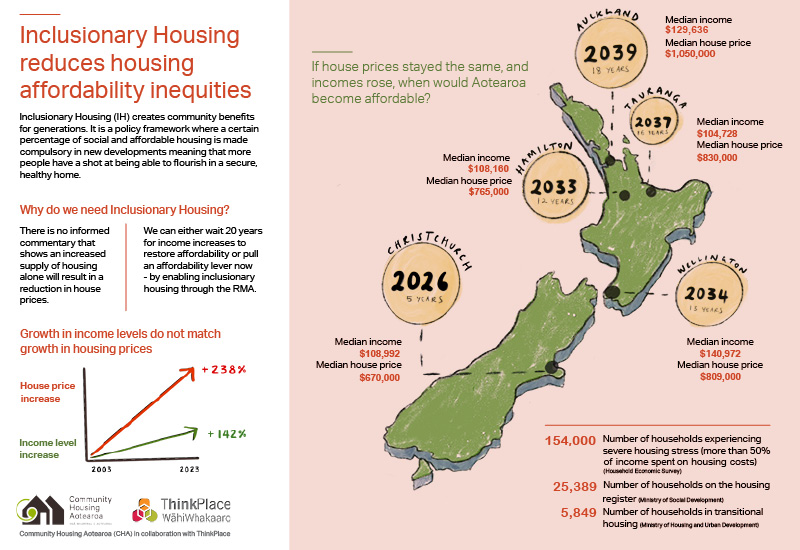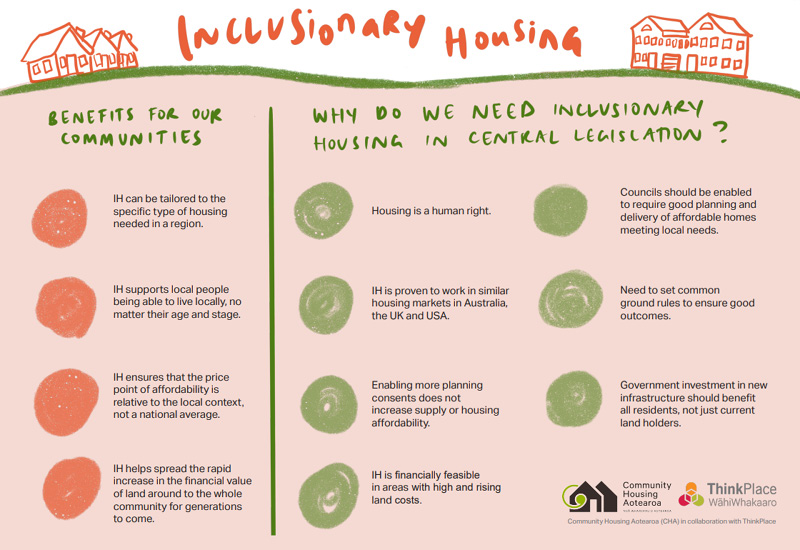Inclusionary Housing

Why does Bridge support Inclusionary Housing (IH)?
Inclusionary Housing (IH) creates community benefits for generations.
It is a policy framework where a certain percentage of social and affordable housing is made compulsory in new developments meaning that more people have a shot at being able to flourish in a secure, healthy home.
IH (previously known as Inclusionary Zoning) is the notion that part of the value uplift resulting from the rezoning of land, should be captured for the benefit of the community.
Inclusionary Housing Infographic
Check out Community Housing Aotearoa’s Latest Infographic on IH
Contact us to see if you can support Inclusionary Housing!
What is Inclusionary Housing?
Peter Southwick, Bridge Housing Trustee explains further
Much has been written about Inclusionary Housing, but it is difficult to find a definition of what Inclusionary Housing really means.
This is an attempt to explain what it is and how it can work to benefit affordable housing providers and through them, our communities.
All land is New Zealand is zoned, with the zoning determining what use land can be put to. For example, land may be zoned rural, industrial, commercial or residential. Zoning designations are set by Local Councils, who decide how best to utilise land in their council areas. Zoning strictly controls the uses to which land may be put. Intuitively this makes sense. For example, nobody wants an industrial factory to be built right next to their dwelling place.
There is a value hierarchy created by the zoning of land. The lowest value land, on a rate per square metre, is invariably rural land and the highest value land is usually commercial land in the middle of large cities. The more intensively land can be used the more valuable it becomes.
Any time land is re-zoned by a Council and it moves from a lower less intensive use, like say rural, to a higher intensity use like residential, it increases substantially in value. By the simple act of a local Council granting a zoning change, changing a parcel of land’s zoning from say rural to residential, a massive change in the land’s value can occur. For example, a rural parcel of land may change from being worth $10 per square metre to $100 per square metre simply because it is rezoned. Once developed, the finished allotments may well sell for $800 per square metre.
The land value increase caused directly as a result of rezoning of land can deliver large windfall profits to the developers involved in this industry, far exceeding the costs and risks involved in developing the land. Inclusionary Housing is a notion that part of the value uplift resulting from a Council’s rezoning of land, should be captured for the benefit of the community.
Inclusionary Housing is a notion that part of the value uplift resulting from the rezoning of land, should be captured for the benefit of the community.
Inclusionary Housing has been used overseas for many years, particularly in the USA and UK. However, it seems that it has been more of a concept to ensure that some affordable housing has been made available in large new developments mixing the affluent and the poor together. Councils give approval to new developments, perhaps trading allowing more intensive development, in return for developers agreeing to incorporate some “affordable housing or units” within their developments. Whilst a useful concept, this is not how we see Inclusionary Housing working successfully in New Zealand.
We say, Inclusionary Housing must have at its heart a transfer of a portion of the land value uplift, resulting from rezoning, by way of either cash or land being donated by the beneficiary of the rezoning, to a community housing provider. The caveat that Councils need to put on any land gifted to a community housing provider, needs to be that the land or cash given by developers will be held in perpetuity for the community’s affordable housing benefit.
One question that arises is; “How much land or cash should be donated to Council/Community Housing by the party benefiting from an effective ‘up-zoning’ of the land?” Our view is that roughly 5% of the value of the finished subdivided, serviced allotments is reasonable. We have seen this in practice in Queenstown, where the Queenstown Lakes Community Housing Trust have entered into multiple successful agreements at around this level.
An example of this transfer of land is as follows. Say a developer achieves a re-zoning of rural land to residential which results in 100 new residential allotments being created. That developer would be required to enter into an agreement to either provide 5% to 8% of their finished, fully serviced allotments to Council, who in turn pass the land on to an affordable housing provider. This could take the form of 5 allotments, or the cash equivalent of the value of 5 allotments, being passed on to an affordable housing provider. This passing of land or cash allows community housing providers to build affordable housing, without the burden of having to pay for the land.
Some developers will argue that such a mechanism will only add to the finished value of houses. In practice this is not so. When a developer is working out how much to pay for a parcel of land with subdivision potential, they effectively start with the gross realisation from all sales and then deduct all their costs of development, as well as an appropriate allowance for profit and risk. They ultimately arrive at what the raw land is worth, or what to pay a seller of the land. If developers are aware that they will have to make a contribution to affordable housing, this will be a deduction from what they will pay for the raw parcel of land. It is not the developers who pay the price of affordable housing, it is the original owner of the land, the owner whose land becomes more valuable simply because it has the potential to attract a higher zoning. In an example such as this, inclusionary zoning does not add to the cost of finished housing, it simply harvests some of the value uplift resulting entirely from the granting of a higher or more valuable zoning by Council.


